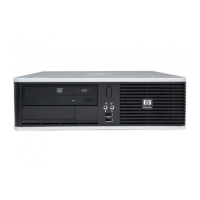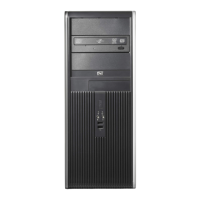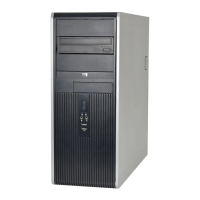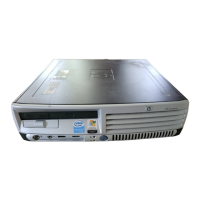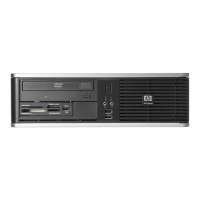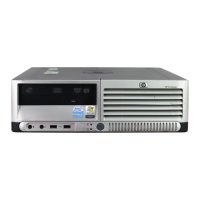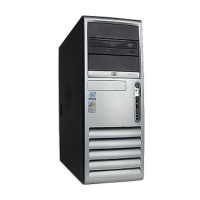
Do you have a question about the HP Compaq dc7900 USDT and is the answer not in the manual?
| Processor | Intel Core 2 Duo, Intel Pentium Dual-Core, Intel Celeron |
|---|---|
| Chipset | Intel Q45 Express |
| Network | Integrated Intel 82567LM Gigabit Network Connection |
| Form Factor | Ultra-Slim Desktop (USDT) |
| Audio | Integrated High Definition Audio |
| Memory | Up to 8 GB DDR2 SDRAM |
| Storage | SATA Hard Drive or Solid State Drive |
| Graphics | Intel Graphics Media Accelerator 4500 |
| Optical Drive | DVD-ROM, DVD+/-RW |
| Ports | USB 2.0, VGA, DisplayPort, serial, parallel, PS/2 |
| Operating System | Windows Vista, Windows XP |
| Power Supply | 135W |
| Expansion Slots | 1 low-profile PCI Express x16, 1 low-profile PCI |
Details the key features of HP ProtectTools modules, outlining capabilities of each component.
Instructions on how to access the HP ProtectTools Security Manager from Windows Control Panel.
Outlines the primary security goals that HP ProtectTools modules help achieve.
Guides administrators through setting up security levels and login methods for the Security Manager.
Details how users can be added and configured with security login methods.
Features for administrators to add, remove, and view user status within HP ProtectTools.
Centralized location for backing up and restoring security credentials from HP ProtectTools modules.
Options for customizing the behavior and appearance of the Security Manager.
Covers the initial setup and configuration steps for Credential Manager.
Process for registering authentication methods like fingerprints or smart cards.
Common tasks users can perform, such as changing passwords or locking workstations.
Enables automatic logon to applications and websites by storing credentials.
How to modify, remove, export, and import application credentials.
Restricting access to applications based on user category, time, or inactivity.
Configuration options available only to administrators for credential properties and settings.
Steps for activating and opening the Drive Encryption module.
Instructions on how to enable and activate the Drive Encryption feature.
Procedure for logging into the system after Drive Encryption is enabled.
Advanced management functions for Drive Encryption, including backup and recovery.
Process for setting up an online account to recover encryption keys.
Steps for recovering encrypted data using local or online recovery methods.
Methods to access and open the Privacy Manager application.
Procedures for requesting, installing, viewing, renewing, and deleting certificates.
Adding, viewing, and deleting contacts for secure communication.
Common operations like signing and encrypting documents and emails.
How to use Privacy Manager features within Microsoft Word, Excel, and PowerPoint.
Configuring and using Privacy Manager for secure email.
Migrating certificates and trusted contacts to another computer.
Instructions for opening File Sanitizer and setting up schedules.
Guidance on choosing predefined or customizing shred profiles for secure deletion.
Specifies shred cycles, assets to include, confirm, or exclude from shredding.
Manual shredding, activating free space bleaching, and viewing log files.
Basic operations like changing a Java Card PIN and selecting a card reader.
Admin-specific tasks like assigning PINs, names, and setting power-on authentication.
Steps to assign a PIN to a Java Card for security purposes.
Enabling and configuring authentication using a Java Card to start the computer.
Overview of managing computer settings via BIOS Configuration utility.
Instructions on how to open and access the BIOS Configuration utility.
Process for viewing and modifying BIOS configuration parameters.
Central location for all security and password-related settings within BIOS.
Steps for enabling and initializing the embedded security chip.
Process for setting up owner passwords and emergency recovery archives.
Creating a user account, Basic User Key, and personal secure drive (PSD).
Performing tasks like encrypting files, folders, and sending encrypted email.
Procedure for changing the password for the Basic User Key.
Managing backup and restore features, and changing owner passwords.
Options for temporarily or permanently enabling/disabling Embedded Security.
Ensuring the device locking service is running for profile application.
Denying access to classes of devices for non-administrators.
Granting or denying specific users/groups access to device types.
Steps to specifically deny access to devices for users or groups.
Common issues and solutions related to Credential Manager functionality.
Troubleshooting common problems encountered with Embedded Security features.
Resolving issues related to device access permissions and configurations.
Addresses various software impact issues and solutions not covered elsewhere.
The task required before Drive Encryption features become accessible.
Definition of a user with full rights to modify permissions and manage others.
Process of verifying a user's authorization to perform a task.
A removable card used for identification and logon, containing security information.


